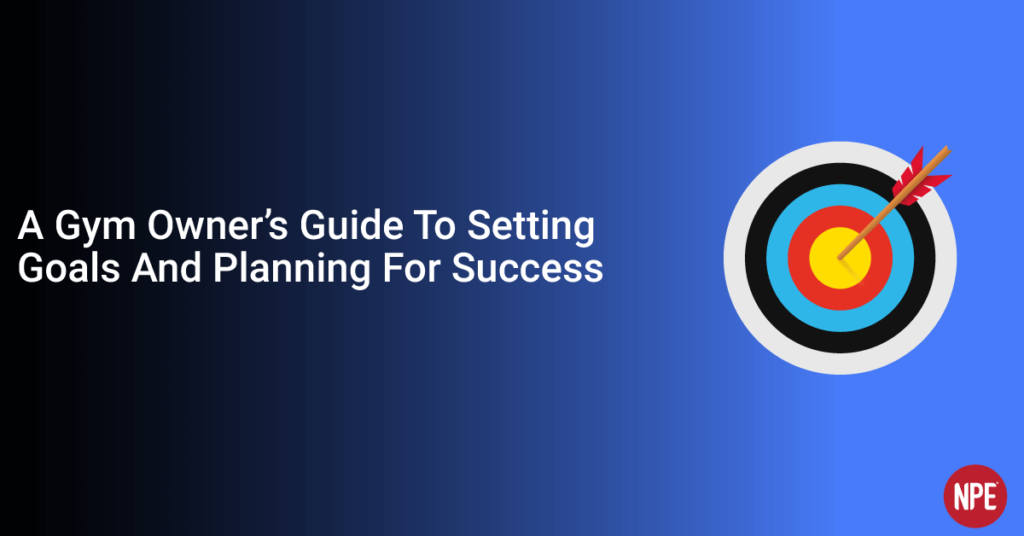A Gym Owner’s Guide To Setting Goals And Planning For Success
By Sean Greeley

When starting out in business, a lot of fitness professionals and business owners want to jump right into the “make more money” part of working on their business.
They’re attracted to learning sales and marketing tactics for getting new clients (and more money) in the door quickly.
After all, that seems like the primary aim for investing time in working on your business… to gain more financial and time freedom… right.
The problem is that most fail to get results with random acts of sales and marketing, or have some initial success then hit a wall (and go backwards), because they haven’t gotten clear on exactly what needs to be done, when it should be done, who will be responsible for it, and how things will evolve over time.
They don’t have a clear plan.
But plans must first be led by setting well-defined goals.
Not vague, weak goals like “I just want to get better” or “I just want some more clients on my schedule.”
I mean a rocking goal that includes all the elements needed to give it real power like “I’m committed to doing _________________ in order to add 30 NET new clients to my business by November 2015.”
See the difference?
But we’re not done yet.
Before you set a rocking goal, you’ve got to be inspired by a dream.
If a goal doesn’t inspire you, then it won’t serve you (or your team when you’ve grown to have staff working for you)
Dreams provide the emotional fuel required to drive intensity and persistence needed in pursuit of a goal.
So, in order to truly grow sustainably over time… you’ve got to have each of the parts and pieces working together.
The formula for success looks like this:
Dream→ Goals → Plan → Action → Review
That may sound like a simple and straightforward formula to follow, but I assure you it is not.
There are many places along the way where things can (and do) go wrong… all the time.
In fact, it’s only a VERY small percentage of business owners that get everything aligned and successfully working together to grow.
But it doesn’t have to be that way.
Everyone is capable of achievement, much like everyone is capable of getting stronger.
You simply must be committed to get in the mental gym and build up your mental muscles.
The more you push yourself out of your comfort zone, the more you grow and gain strength over time.
In this guide, we’re going to take you through the process from start to finish.
And our learning objectives are for you to:
1. Understand the Dream → Goal → Plan → Action → Track & Review cycle
2. Identify areas where your thinking and behavior are flawed right now, and how you can make adjustments to improve
3. Walk you through a cycle of this process from start to finish that you can use to move yourself (and your business) forward in a powerful way to grow
Without further ado, let’s begin…
STEP 1: DREAM
Dreams are the rocket-fuel that drives all major accomplishments in business (and life).
Dreams are powerful stuff!
And dreaming is a time where we visualize, create, and imagine a future that we can’t yet see.
A future that doesn’t exist in the physical sense yet, because it must first exist in your mind.
And this applies to all areas of your life.
Your physical health, relationships with family and friends, finances, learning and education that inspire you, and even spiritual fulfillment (whatever that means for you).
A dream must also be taken a step further and molded down into a vision.
Dreams are generally very broad.
Turning your dreams into a vision is where they get refined.
Your dream and vision must inspire you to get up and go to work everyday, and it should liven up your spirit in ways that you only experience when you’re living life to the fullest.
Think about a short-term vision (less than 1 year) that inspires you, as well as a long-term vision (3-5+ years) that gets you excited too.
Some business owners do best starting with their long-term and working backwards to define the short-term (this is also called reverse engineering).
Others find it easier to start with the short-term then stretch their thinking out further from that point.
There is no right or wrong way to dream or mold your vision.
Find a place to start, and keep working on it until you get there.
And go through this process for both your business and your personal life.
If your business doesn’t support your personal vision, then keep adjusting until you’ve got these working together in harmony.
Harmony doesn’t mean that you won’t be required to make sacrifices in your personal life in order to pursue your business vision at times. You will. But it simply means that you keep your eyes on both sides of the coin and continue adjusting as necessary to have them working together in support of one another.
Once you’ve gotten clarity on your dream and vision, you’ve got magic in a bottle.
Hold onto it tight!
It’s the rocket fuel needed to get you to the moon.
STEP 2: GOALS
Many people set goals that are weak.
Weak in the sense that they don’t include “measures of success,” deadlines, or owners to assign accountability.
In order to make a goal powerful, it must be specific, measurable, attainable, relevant, and time bound (S.M.A.R.T.).
Now, I know you’ve likely heard of this before.
And therefore you’ll want to gloss over the rest of this section.
You might even be telling yourself, “I understand this already, I’m good, I’ll continue on to see if I can learn anything new here.”
Don’t make that mistake.
Intellectually knowing something is one thing.
But actually DOING IT is a whole different animal.
Think you already have a well-defined goal?
Great.
Show me.
Run it through the checklist I’ll share with you at the end of this article.
If you’ve missed one detail, go back and make it stronger.
And even if you haven’t, I’d wager you can still make it stronger again.
Let’s review what having a S.M.A.R.T. goal really means and how you can apply it to setting more powerful goals.
Specific: Don’t say, “I want to grow.” That’s vague. There are lots of ways to grow. Hopefully, you are growing right now by reading this. Instead say, “I will add X new clients to my business.”
Measurable: Punch up the “add X new clients” statement by getting a defined target in there. And rather than simply focusing on new client acquisition (a mistake most business owners make), give it more power by focusing on NET new clients (which accounts for acquisition and retention at the same time). Here’s an example, “Add 25 new clients for a net target of 75 active clients on the books” is much better.
Attainable: I’m all for big goals that both challenge and scare the heck out of you. But make sure you’re not setting yourself up for failure. If you’re just starting out, let’s not go for 300 new clients by next month. Let’s focus on simply adding 10-25 new clients in a reasonable time frame.
Relevant: Do 25 new clients move you toward your dream today? If so, great, let’s continue. If you’ve set a goal that’s not as relevant to your dream, go back and tweak it. You must stay focused on goals that move you toward your dream, not random goals that just sound like a good idea but don’t align with your long-term vision.
Time bound: A goal without a deadline is still just a dream. And while dreams are the source and power of where all great things begin, it’s time to put some teeth around your dream by transforming it into a powerful goal with a deadline that will create pressure for you to take action.
It’s powerful to set goals in multiple areas of your business and life.
It’s also important that you define time frames for accomplishment of your goal.
And in business we talk about goals in context of annual, quarterly, monthly, weekly, and even daily.
One of the most common mistakes is to set goals that are super aggressive and don’t have a realistic time frame associated with their accomplishment.
In general, you can pretty much do anything you want in business (and life) given enough time and money to make it happen.
Just be willing to have some patience with the process.
And remember, whatever you plan for… count on it taking more time, effort, energy, money, and everything else to accomplish than you originally anticipated.
Working through that process is called learning.
STEP 3: PLAN
Planning involves thinking through each of the steps required to accomplish your goal.
List out each of the tasks required.
Assign an owner to each task.
Give each task a deadline.
Ensure that your plan is well thought through so that deadlines are built appropriately given the time and resources you have available to commit to working on your goal.
A plan that is unrealistic creates frustration and disappointment.
Your plan should give you exciting momentum towards your goal.
That being said, great businesses grow from leaders who set unreasonable and unrealistic goals and plans for themselves and others.
Don’t be afraid to push yourself beyond your comfort zone to accomplish things you never before thought possible.
In fact, expect to be working outside your comfort zone. That’s what growth is all about!
Where lies the appropriate balance between the two?
That’s the art and science of goal setting and planning.
Sometimes it’s helpful to break your project or plan into “phases” or buckets for different sections. This makes it easier to clarify your thinking in each area.
And thinking is the sport of business!
For instance, in launching a new marketing campaign, you might create sections for:
– Target market research
– Campaign strategy and offers
– Lead generation
– Contact capture
– Follow up conversion
And then create tasks for each of the items required in the various areas of a new marketing campaign.
By having sections, you can think better about each individual area… rather than trying to think about all of it at once and missing something.
The mind, and planning, works best in “chunks.”
STEP 4: ACTION
“A good plan violently executed now is better than a perfect plan executed next week.” – George S. Patton
The best-laid plans are meaningless without action.
On the flip side, lots of action without good planning beforehand leads to needlessly wasted energy and effort.
That’s ok when you’re just starting out.
Just like an out-of-shape adult, doing ANY activity will move you in the right direction when you’ve been sedentary.
But as you progress, training needs to be planned, as does nutrition and recovery to get optimal results.
And when you’re already an elite athlete, well, it generally takes a whole lot of effort to move the needle a few percent in the right direction.
Work (and business) is the same.
Action is good.
But good planning first, followed by action, is a whole lot better.
A lot of people describe their problem with lack of action as a “time management” problem.
But the truth is you don’t manage time, time just ticks along the same each day for all of us.
You only have the ability to manage your focus and activities.
Which also requires planning, and then much discipline to maintain.
Focus, like time, is also a finite resource.
There is only so much you can focus on accomplishing at once!
I know, I know.
You want to do it all now.
But the facts are you can’t focus on everything all at the same time.
You must prioritize your focus.
One of the most powerful questions you should be asking in business (and life) is,
“What’s the most important area for me to focus on right now?”
And that question must be answered in the context of annual, quarterly, monthly, weekly, and even daily priorities.
And your priorities in each of those time frames must all be aligned with one another.
For instance, what I’m prioritizing this week… needs to be aligned with my priorities for this month and quarter… and so on.
So plans and actions must be tightly tied and aligned for success.
And actions must be tied to your calendar.
Too many business owners make a great plan, but haven’t thought through where they can block time to commit to making it happen on their calendar.
And of course the more you’re stuck working inside the operations of your business (working with clients everyday), the less time you have to devote towards strategic projects that grow other areas of your business like sales and marketing, recruiting and hiring, team development, and more.
So, what’s the best way to approach this?
Ensure you’ve got the right priorities, a well thought out plan of action, and the resources (time and money) available to make it happen.
Then go do it!
And keep going until you finish your plan.
STEP 5: REVIEW
Review must be the most powerful word in business.
No plans ever work out perfectly.
And success is never achieved in a straight line.
You must consistently measure progress toward your goal, adjust as necessary, and continue working until you hit the mark.
It’s said that when performance is measured, it improves.
When it’s measured and reported, it improves dramatically.
But when it’s measured and reported publicly, it improves exponentially.
When you make your goals public, then track and report progress… you’re on the hook for all to see.
There’s no “whinging out” as the Brits say.
You’ve got to show up and deliver results!
And that pressure to perform inspires action and course correction as needed.
Another important component of the review process is to celebrate success along the way.
Most successful entrepreneurs are Type-A, goal driven people. They’re happy when they’re winning, and it’s all too easy to become focused on what’s left undone rather than what’s been completed.
While that may be one strategy (not necessarily the best one) for the entrepreneur, it’s generally not the best for building your team.
You’ve got to build their confidence and motivation to continue.
So take time to recognize the wins.
Celebrate success and find a positive focus each time you meet and review.
That doesn’t mean you don’t need to hold yourself and others accountable to getting things done. You do.
But have some fun, remember to laugh once in a while, and enjoy the ride.
Attitude and perspective are great tools we all have at our disposal in each moment of every day. If you’re not having fun, try using those tools to adjust yourself and remember to be grateful for the journey!
Summary
Thinking is the sport of business.
And the better you can think, the better you are playing the game.
Each step of the dream, goals, plan, action, and review process is critical to ensure your success and accelerate your progress to grow faster with less effort.
And remember that life is short.
While hitting goals is awesome, remember to have fun and celebrate success along the way.
When you’re not enjoying the journey, try adjusting your attitude and perspective. You alone control those each moment of every day.












